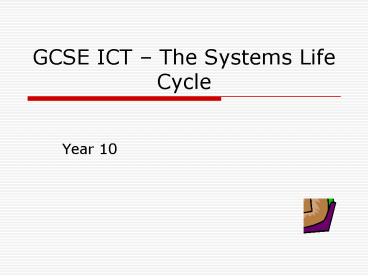GCSE ICT The Systems Life Cycle - PowerPoint PPT Presentation
1 / 21
Title:
GCSE ICT The Systems Life Cycle
Description:
Better management information is required for decision-making. ... investigating and analysing the existing system to establish how things work currently ... – PowerPoint PPT presentation
Number of Views:917
Avg rating:3.0/5.0
Title: GCSE ICT The Systems Life Cycle
1
GCSE ICT The Systems Life Cycle
- Year 10
2
The Systems Life Cycle
- Objectives
- To learn the stages in the systems life cycle
- To understand the role of the systems analyst
3
The systems life cycle
4
Why introduce a new system?
- The current system may no longer be suitable for
its purpose. - Technological developments may have made the
current system redundant or outdated. - The current system may be too inflexible or
expensive to maintain, or may reduce the
organisations ability to respond quickly enough
to customers demands. - Better management information is required for
decision-making. - The provision of better customer service.
5
The role of the systems analyst
- investigating and analysing the existing system
to establish how things work currently - performing a feasibility study to judge whether a
new computer system is feasible - designing the new system, specifying programs,
hardware, and procedures to be followed - testing and overseeing the installation of the
new system - making sure that all user and technical
documentation is complete - evaluating the performance of the new system to
make sure it fulfils the requirements
6
The feasibility study
- The purpose is to see if it is worth going ahead
with a new system.
7
Feasibility study questions
- What are the problems with the existing system?
- Can the problems be solved?
- How much will it cost?
- What is the scope of the project?
- What must the new system do?
- What are the benefits of a new system?
- What are the recommendations?
8
The feasibility report
- The findings of the feasibility study are
summarised in a document called the feasibility
report. - The report is shown to senior managers, who use
it to decide whether or not to go ahead with the
new system.
9
The feasibility study
Technical feasibility Economic feasibility Legal
feasibility Operational feasibility Schedule
feasibility
10
Analysis - Investigating the current system
- Interviewing staff
- Examining current business and systems documents
and output. - Sending out questionnaires and analysing
responses - Observation of current procedures, by spending
time in various departments.
11
Analysis Understanding the problems
- Identifying problems with the current system
- Identifying the needs of users
- Investigating similar systems elsewhere
- Investigating what input, processing and output
are needed - Establishing what tasks need to be completed
- Establishing deadlines for completion of tasks
12
Analysis Tools
- Flow charts
- Data flow diagrams
- Structure diagrams
13
Design
- The design stage looks at how the new system will
be built. - Ict systems can be broken down into
- Input Process Output
- This stage looks at the design of all three.
- When the design is complete, a document called a
design specification is created. - This is shown to users for their comments.
14
The Design Specification
- The hardware platform (PC, mainframe)
- The software (off the shelf, bespoke)
- The outputs (hardware, reports)
- The processing (sorting, searching, grouping)
- The inputs (data capture, input devices)
- Storage (devices, method)
- Security and backup
- The user interface (GUI, command line)
- The modular design of each program in the
application - The test plan and test data
- Conversion plan
- Documentation including systems and operations
documentation. Later, a user manual will be
produced.
15
Implementation
- Programs written, tested and documented
- Data loaded from old system to new system
- Staff trained on new system
- May be parallel running of both systems for a
while or direct implementation or phased
implementation - System maintained by keeping it up-to-date,
solving any problems and writing new programs
when required.
16
Testing
- As soon as a system is developed it should be
checked against user requirements to ensure the
system does everything the user wants.
17
Testing Four stages
- System tested with data that contains no errors
to see if it produces correct results. - Known errors are introduced into the data to see
how the system handles them - Output is produced and checked
- Extreme data is entered to ensure range checks
are included as part of validation
18
Test plan
19
Documentation
- Two types of documentation are produced
- User guide so that users can learn to use the
system - Technical documentation so that the system can
be maintained
20
Evaluation
- Does the system meet all user needs?
- Is it functioning correctly?
- Are any improvements needed?
21
Maintenance
- Providing support for users
- Providing enhancements
- Creating patches (fixing bugs)
- Improving software (updates)































